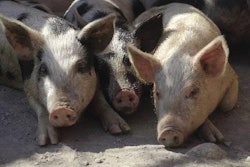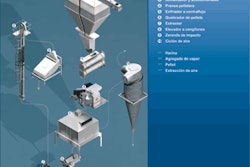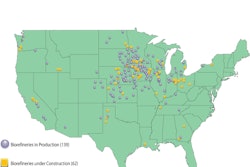Increasing environmental concerns and the desire to optimize profitability from egg production has stimulated recent interest in composting manure as a value-added product.
The volume of manure and nutrient composition from hybrid Leghorn strains are shown in Table 1 and are based on studies conducted at the Pennsylvania State University during 1996 on hens and in 1997 on pullets. The values for hens include averages for first and second cycle flocks adjusted to a 52-week period. Nutrient composition is based on average values from replicate samples over the production cycle for hens and from the 18-week growing period for pullets.
Table 2 indicates the nutrient composition of manure from egg production flocks as determined by the University of Georgia in 2004.
Data derived from high-rise houses and from lagoons suggests that a complex of one million hens in a multi-age in-line unit together with 300,000 pullets will produce 15,000 tons of manure over 52 weeks with a moisture content averaging 60 percent. In the process of composting, manure should be dried to a moisture content of 25 percent, representing a theoretical mass of 10,000 tons.
A source of carbon in the form of woodchips, straw or stubble must be added to facilitate composting. Allowing a 30 percent addition rate in relation to the volume of raw manure, 4,500 tons of cellulosic material would be required each year. It is calculated that the manure from one million hens plus the cellulose would produce 20,000 tons of saleable product each year.
There are a number of commercial composting systems available. In principle, manure is removed regularly from houses and deposited in windrows in a covered shed. A composter runs along the rows at one- to three-day intervals, agitating, mixing and redistributing product in each row. Acombination of anaerobic fermentation within the pile and some aerobic fermentation at the surface increases temperature above 145 F, often achieving 155 F. Maintaining a minimum of 138 F for 36 hours will effectively destroy aerobic bacteria including E. coli and Salmonella spp. The duration of composting varies according to the moisture content of manure, which should be held at a level greater than 40 percent during the early phase of the composting process, the proportion of carbon additive, the frequency of turning and efficiency of the windrow composter.
Commercial composting systems
Salmet - The Salmet (www.salmet.com) composting system is widely used in Europe and a number of installations are in operation in the United States and Canada. A typical system for one million hens comprises three composting sheds 100 feet x 460 feet. Each shed has a single composter which processes two windrows each day on a three-day cycle. Manure is transported from houses by a conveyor and is deposited at the end of a selected row at approximately three-day intervals in rotation. Composters traverse the windrows on metal rails placed on raised concrete forms. The front 110 feet of the house has a concrete floor and an external pad. A special trailer is used to move the composter among the six windrows. The front 100 feet of each of the buildings is cladded in metal with the remaining 350 feet constructed similar to a plastic greenhouse. Fans are installed to remove excess moisture released from the composting manure. Salmet claims rapid composting using their system with conversion of manure into a saleable product within two to three weeks.
Farmer Automatic - Farmer Automatic of America (www.farmerautomatic.com) markets the CompostCat for high rise houses. This unit is self-propelled and can move between houses. Each of the four wheels, with rubber tires, is driven by a hydrostatic system with planetary drive units in the torque hubs. This allows for maneuverability in the area under the cage rows. The pick-up head can be controlled by the operator according to the height of the windrow. A center auger agitates material which is conveyed through the center of the machine onto a rear discharge belt. This layers the material undergoing composting onto the windrow. One Farmer Automatic composter can service a one-million hen complex. It requires approximately 50 to 60 minutes to turn a windrow up to 8 feet wide by 3 feet high with a suggested frequency of 3 to 5 days. The manufacturers claim to have sold 30 units in North America.
Farm examples
A large integrator in the Midwest with approximately two million hens operates a composting plant comprising two buildings approximately 500 feet x 70 feet, each with four bays. A U.S.-manufactured Frontier-F Series Composter (www.frontierindustrial.net) turns the mixture of manure and a carbon source to achieve optimal composting. This system requires one to two months to obtain a uniform product marketed widely for use on golf course greens, sports fields, and lawns.
The availability of natural gas on the farm has enabled a large egg producer in a Western state to develop both drying and composting systems. Manure is collected from beneath cages by scrapers and is transferred from the house to trucks using augers installed at the end of every unit. Each day waste is transferred to a custom-built dryer similar to an alfalfa dehydrating plant. The gas-fired unit produces dried poultry waste of uniform consistency which is then bagged or sold in bulk. The company also operates a composting plant that requires manure to be mixed with a carbon source and is turned using a custom-constructed composter operating over a series of concrete pads. Although the company converts and distributes most of the manure produced by flocks in the form of dried poultry waste, a significant proportion is sold to nurseries and retail outlets for landscaping, gardens, and potted plants.
Positive economics
Table 3 depicts capital and operating costs for conversion of poultry manure to compost using a dedicated on-site plant. A one-million hen operation could generate an annual revenue of $525,000 given an output of 15,000 tons of product, sold in bulk at $35/ton. With a total cost of $431,500 annually and allowing a saving of $20,000 for fly control, the contribution of $113,000 per year would represent an offset of up to 0.47cents per dozen on an annual throughput of 24.3 million dozen eggs.
A hypothetical one-million hen operation could generate a contribution of $264,700 annually representing a 1.09 cent per dozen reduction in production cost.
With increased feed costs and environmental restraints, U.S. producers should consider composting manure to reclaim as much value as possible from in-line operations. Capital expenditure for an in-house composter suitable for high rise houses generates a more favorable contribution ($264,700 annually or 1.09 cents per dozen) compared to a free-standing composting plant suitable for complexes with compact manure belt batteries ($113,000 annually or 0.47 cents per dozen). The pay-back period for in-house composting is 17 months taking into account interest, overhead, depreciation and variable expenses.
Editor's Note: Representatives of egg production operations interviewed for this article requested anonymity and accordingly their operations have not been identified.

















